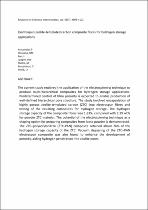 ResearchSpace
ResearchSpace
Electrospun zeolite-templated carbon composite fibres for hydrogen storage applications
JavaScript is disabled for your browser. Some features of this site may not work without it.
- ResearchSpace
- →
- Research Publications/Outputs
- →
- Journal Articles
- →
- View Item
| dc.contributor.author |
Annamalai, Perushini

|
|
| dc.contributor.author |
Musyoka, Nicholas M

|
|
| dc.contributor.author |
Ren, Jianwei

|
|
| dc.contributor.author |
Langmi, Henrietta W

|
|
| dc.contributor.author |
Mathe, Mahlanyane K

|
|
| dc.contributor.author |
Bessarabov, D

|
|
| dc.contributor.author |
Petrik, LF

|
|
| dc.date.accessioned | 2017-09-06T09:31:05Z | |
| dc.date.available | 2017-09-06T09:31:05Z | |
| dc.date.issued | 2017-01 | |
| dc.identifier.citation | Annamalai, P., Musyoka, N.M., Ren, J. et al. 2017. Electrospun zeolite-templated carbon composite fibres for hydrogen storage applications. Research on Chemical Intermediates, vol. 43(7): 4095-4102. DOI: 10.1007/s11164-017-2867-x | en_US |
| dc.identifier.issn | 0922-6168 | |
| dc.identifier.uri | DOI: 10.1007/s11164-017-2867-x | |
| dc.identifier.uri | https://link.springer.com/article/10.1007/s11164-017-2867-x | |
| dc.identifier.uri | http://hdl.handle.net/10204/9542 | |
| dc.description | Copyright: 2016 Springer. Due to copyright restrictions, the attached PDF file only contains the abstract of the full text item. For access to the full text item, kindly consult the publisher's website. | en_US |
| dc.description.abstract | The current study explored the application of the electrospinning technique to produce multi-hierarchical composites for hydrogen storage applications. Predetermined control of fibre porosity is expected to enable production of well-defined hierarchical pore structure. The study involved encapsulation of highly porous zeolite-templated carbon (ZTC) into electrospun fibres and testing of the resulting composites for hydrogen storage. The hydrogen storage capacity of the composite fibres was 1.83%, compared with 2.39 wt% for powder ZTC material. The potential of the electrospinning technique as a shaping option for preparing composites from loose powder is demonstrated. The ZTC–polyacrylonitrile (ZTC-PAN) composite retained about 76% of the hydrogen storage capacity of the ZTC. Vacuum degassing of the ZTC–PAN electrospun composite was also found to enhance the development of porosity, aiding hydrogen penetration into zeolite pores. | en_US |
| dc.language.iso | en | en_US |
| dc.publisher | Springer | en_US |
| dc.relation.ispartofseries | Worklist;18613 | |
| dc.subject | Zeolite 13X | en_US |
| dc.subject | Zeolite-templated carbon | en_US |
| dc.subject | Electrospinning | en_US |
| dc.subject | Hydrogen storage | en_US |
| dc.title | Electrospun zeolite-templated carbon composite fibres for hydrogen storage applications | en_US |
| dc.type | Article | en_US |
| dc.identifier.apacitation | Annamalai, P., Musyoka, N. M., Ren, J., Langmi, H. W., Mathe, M. K., Bessarabov, D., & Petrik, L. (2017). Electrospun zeolite-templated carbon composite fibres for hydrogen storage applications. http://hdl.handle.net/10204/9542 | en_ZA |
| dc.identifier.chicagocitation | Annamalai, Perushini, Nicholas M Musyoka, Jianwei Ren, Henrietta W Langmi, Mahlanyane K Mathe, D Bessarabov, and LF Petrik "Electrospun zeolite-templated carbon composite fibres for hydrogen storage applications." (2017) http://hdl.handle.net/10204/9542 | en_ZA |
| dc.identifier.vancouvercitation | Annamalai P, Musyoka NM, Ren J, Langmi HW, Mathe MK, Bessarabov D, et al. Electrospun zeolite-templated carbon composite fibres for hydrogen storage applications. 2017; http://hdl.handle.net/10204/9542. | en_ZA |
| dc.identifier.ris | TY - Article AU - Annamalai, Perushini AU - Musyoka, Nicholas M AU - Ren, Jianwei AU - Langmi, Henrietta W AU - Mathe, Mahlanyane K AU - Bessarabov, D AU - Petrik, LF AB - The current study explored the application of the electrospinning technique to produce multi-hierarchical composites for hydrogen storage applications. Predetermined control of fibre porosity is expected to enable production of well-defined hierarchical pore structure. The study involved encapsulation of highly porous zeolite-templated carbon (ZTC) into electrospun fibres and testing of the resulting composites for hydrogen storage. The hydrogen storage capacity of the composite fibres was 1.83%, compared with 2.39 wt% for powder ZTC material. The potential of the electrospinning technique as a shaping option for preparing composites from loose powder is demonstrated. The ZTC–polyacrylonitrile (ZTC-PAN) composite retained about 76% of the hydrogen storage capacity of the ZTC. Vacuum degassing of the ZTC–PAN electrospun composite was also found to enhance the development of porosity, aiding hydrogen penetration into zeolite pores. DA - 2017-01 DB - ResearchSpace DP - CSIR KW - Zeolite 13X KW - Zeolite-templated carbon KW - Electrospinning KW - Hydrogen storage LK - https://researchspace.csir.co.za PY - 2017 SM - 0922-6168 T1 - Electrospun zeolite-templated carbon composite fibres for hydrogen storage applications TI - Electrospun zeolite-templated carbon composite fibres for hydrogen storage applications UR - http://hdl.handle.net/10204/9542 ER - | en_ZA |





